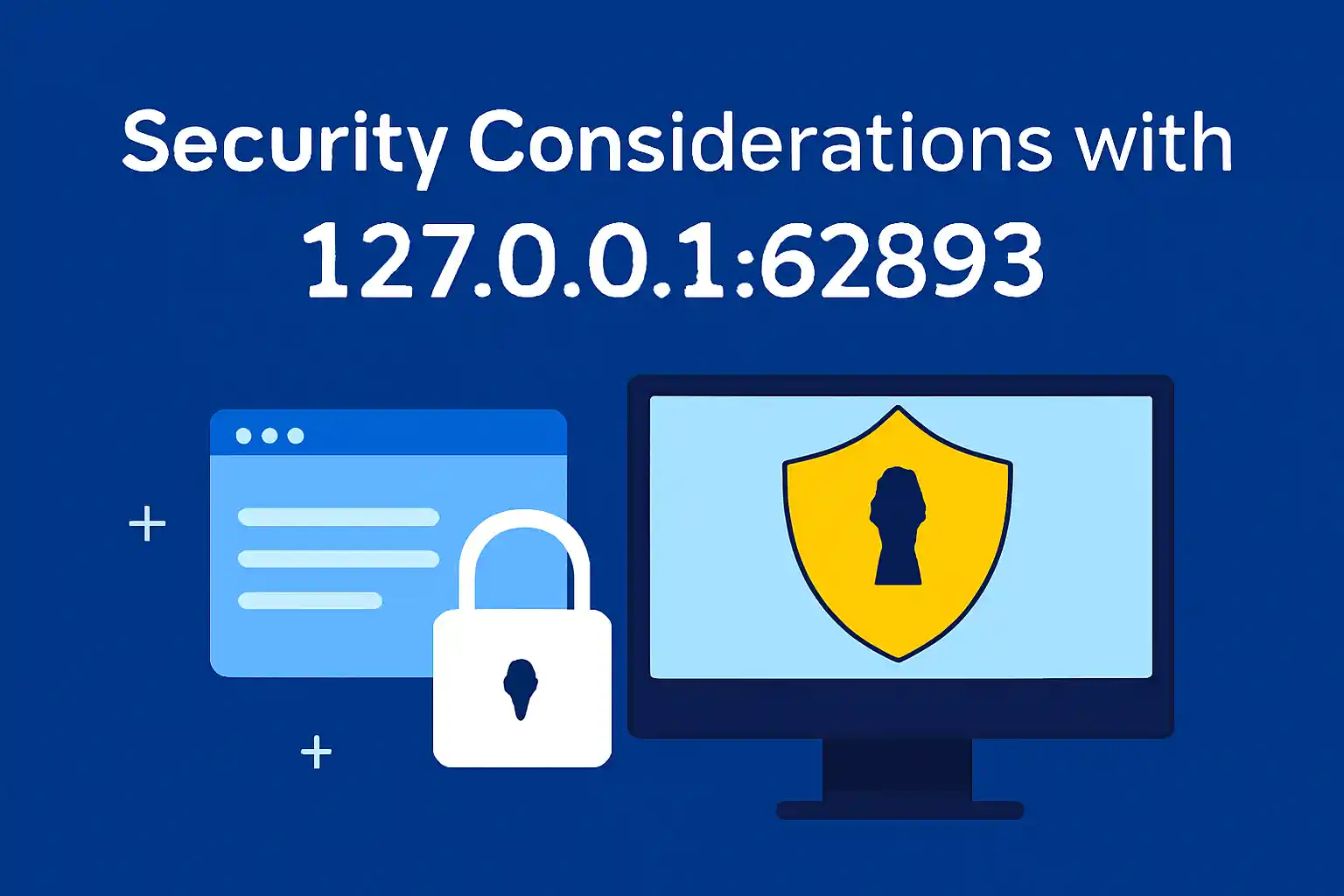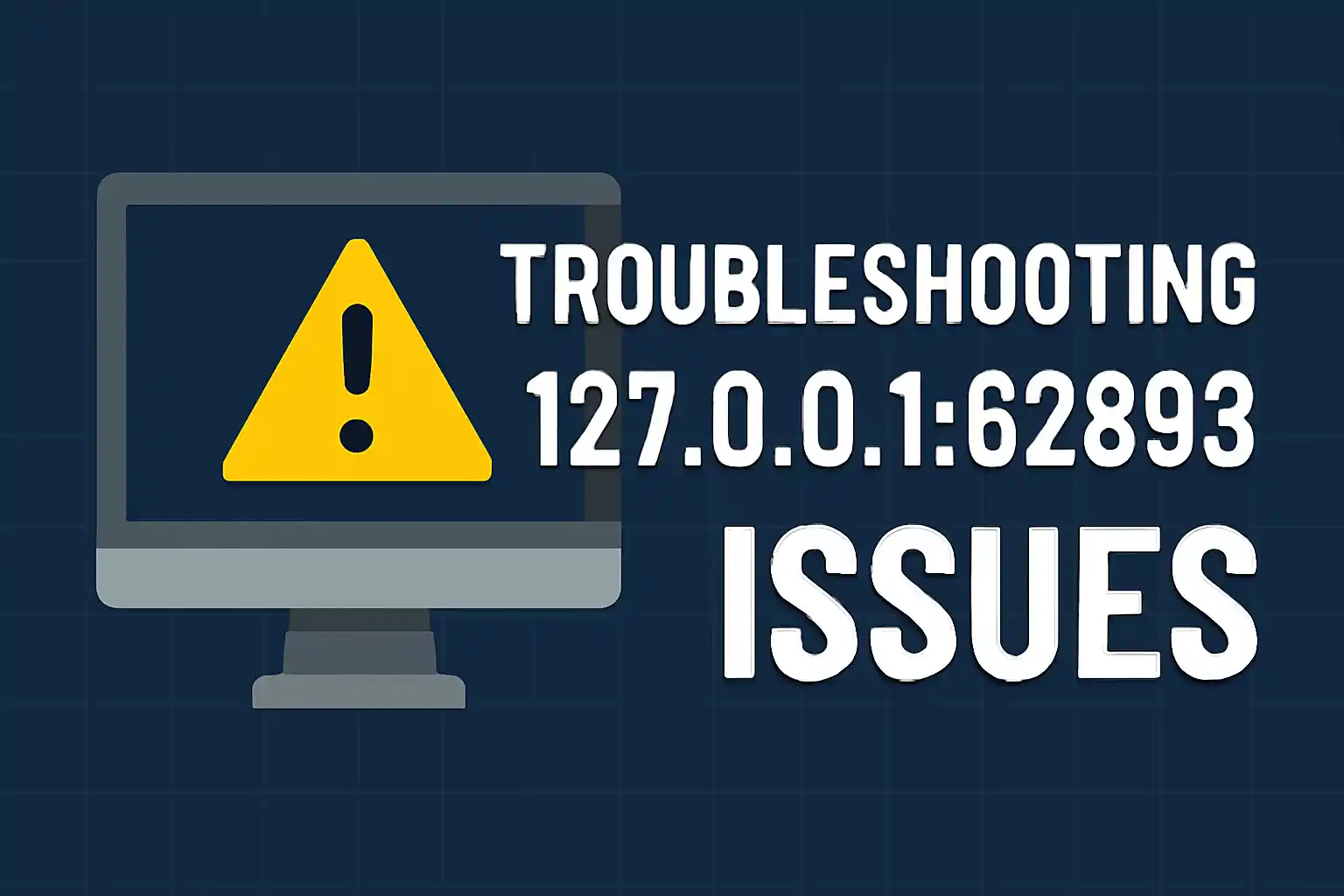Complete Guide to 127.0.0.1:62893: Localhost & Port Usage

Introduction
In the world of networking and software development, you might have come across the term 127.0.0.1:62893. While it might look like a complex string of numbers and letters, it’s actually a simple and essential part of how computers communicate with themselves. Understanding what 127.0.0.1:62893 means and how it works can greatly help anyone who’s involved in web development, software testing, or networking.
So, what exactly does 127.0.0.1:62893 represent?
- 127.0.0.1 is commonly known as the loopback address or localhost, which refers to your own computer or device.
- 62893 is a port number that helps identify a specific service or application running on your computer.
Together, 127.0.0.1:62893 allows you to test and run applications locally, without needing an internet connection. It’s especially useful for developers who want to test websites, web servers, databases, and other services in a controlled, private environment.
In this guide, we’ll explore how 127.0.0.1:62893 works, its common uses, how to troubleshoot issues, and best practices for working with localhost and port numbers. By the end, you’ll have a clear understanding of how to use this address and port in your own development projects.
What is 127.0.0.1?
The IP address 127.0.0.1 is often referred to as the loopback address or localhost. It’s a special IP address used in networking to allow a computer to communicate with itself. When data is sent to 127.0.0.1, it doesn’t go out to the internet; instead, it stays within the local machine, essentially making the computer its own server. Think of it as a testing ground for your computer to check whether its networking capabilities are working correctly.
Why is 127.0.0.1 Used?
127.0.0.1 serves an essential function in networking and development:
- Internal Communication: It’s used to send data from a program or service on a computer to another program or service on the same computer. This is crucial for tasks like running a web server or testing databases locally.
- Security for Testing: Since data never leaves the computer when using 127.0.0.1, it’s ideal for testing applications without risking exposure to the internet. Developers can run their services locally to check if everything works before making them public.
- Common in Development: Web developers frequently use 127.0.0.1 to set up local web servers. This allows them to view and test websites or applications as though they were on the internet but without actually hosting them publicly.
A Simple Example
Imagine you are building a website. Instead of pushing the website live to the internet right away, you would run it on 127.0.0.1 first. This way, you can make sure everything works, such as the layout, the database, and the server configuration, without exposing it to the world.
In short, 127.0.0.1 is like a “home address” for your computer, but it only refers to your device and no one else’s. This makes it an invaluable tool for software development, testing, and even for debugging issues on your machine.
What is Port 62893?
In the world of networking, a port number is essential for directing data to specific services or applications on your computer. Port 62893 is one such dynamic port, which is often used for temporary or private services. While port numbers like 80 or 443 are associated with standard services (such as web traffic), port numbers in the range of 49152 to 65535, like 62893, are typically assigned for short-term tasks or testing purposes.
Understanding Port Numbers
A port number acts as a “gatekeeper” to help your computer direct traffic to the right service. When data is sent to a particular IP address, the port number tells the computer which application should handle that data. Think of the IP address as the building and the port number as the specific room or service inside that building.
Port 62893 is an example of a dynamic or ephemeral port. These types of ports are assigned by your operating system to temporary services that are running on your local machine. They are not fixed like well-known ports (such as port 80 for HTTP or port 443 for HTTPS) and are typically used by software that needs a random, temporary port.
Why is Port 62893 Important?
- Dynamic and Temporary: Port 62893 is dynamically assigned, meaning it’s often used by applications that need to communicate temporarily and don’t require a fixed port number.
- Used for Local Services: When you run a local application (like a local web server or a database), it might use port 62893 to handle communication within your computer. It ensures that data meant for your application is directed to the right service without any conflicts.
- Common in Testing and Development: Developers use ports like 62893 when they want to avoid interfering with other services that might already be using well-known ports.
An Example of Port Usage
When you’re testing a website locally using 127.0.0.1, you might run a web server application that listens on port 62893. This means that the server would accept requests sent to 127.0.0.1:62893 and handle them accordingly. By using such dynamic ports, developers ensure that their local services run smoothly without interfering with more critical or permanent services on their machine.
How Does 127.0.0.1:62893 Work?

Now that we understand what 127.0.0.1 and port 62893 are, let’s break down how they work together in a simple way. When combined, 127.0.0.1:62893 allows your computer to run services and applications locally without needing to connect to external networks or servers.
Step-by-Step Explanation
- The IP Address – 127.0.0.1:
- 127.0.0.1 is known as the loopback address, and it refers to your own computer. When an application sends data to 127.0.0.1, it doesn’t go outside of your system—it stays internal. It’s like sending a message to yourself.
- This is useful for testing and development because it lets you simulate how an application or service will behave without actually exposing it to the internet.
- The Port Number – 62893:
- The port number 62893 is like a door through which the data can pass to a specific service or application. It’s an identifier that tells your computer which program should handle the incoming data.
- Think of the IP address as the address of your house and the port number as the room in that house where the data should go. Port 62893 can be assigned to a specific program or service running locally.
- How It All Comes Together:
- When you access 127.0.0.1:62893, your computer sends data to itself using this specific combination of IP address and port number. The service listening on port 62893 will then handle the data.
- For example, if you’re running a local web server or database, these services might listen on 127.0.0.1:62893 to process requests and send responses—all without needing to connect to the internet.
Real-World Example
Let’s say you’re a developer building a website and you want to test it on your local computer. You set up a web server to run the site locally, and the server listens on 127.0.0.1:62893. When you open your web browser and type http://127.0.0.1:62893 into the address bar, your computer sends the request to that server. The server, listening on port 62893, processes the request and displays your site on the screen. This entire process happens locally without involving external servers or the internet.
In short, 127.0.0.1:62893 is a combination of an address (your local computer) and a port (the specific service) that enables local communication, making it easier for developers to test and run applications safely and securely.
Common Use Cases for 127.0.0.1:62893
The combination of 127.0.0.1:62893 plays an essential role in various networking and development tasks. Whether you’re a developer, a network administrator, or just someone experimenting with local services, understanding the practical uses of 127.0.0.1:62893 can help you optimize your workflow. Let’s explore some of the most common use cases for this IP address and port number.
Local Development and Testing
One of the most common uses of 127.0.0.1:62893 is for local development. Developers use 127.0.0.1 as the loopback address to test applications locally before deploying them to a live environment.
Example:
- Web Development: If you’re building a website, you can run a local web server on 127.0.0.1:62893. This allows you to view your site in a browser on your own computer without making it publicly available on the internet.
- Software Testing: When testing software, especially database-driven applications, developers use 127.0.0.1:62893 to simulate live interactions without needing an external server. This ensures that all features and services work before they go live.
Debugging Local Services
Another frequent use of 127.0.0.1:62893 is for debugging. When you run services locally, you can use this address to troubleshoot issues without affecting live servers.
Example:
- Database Debugging: If your application connects to a local database, you can test it by connecting to 127.0.0.1:62893. If there’s an issue with the database connection, you can debug it locally before trying to fix the issue on a live database.
Running Local Servers
Developers often set up local servers to simulate a full working environment for their applications. This is particularly useful when creating web applications, APIs, or microservices.
Example:
- Web Servers: A developer might run a local instance of a web server, such as Apache or Nginx, on 127.0.0.1:62893. By doing this, they can view and test their websites as though they were on a live server, but without the need to deploy them online.
- API Testing: If you’re developing an API, 127.0.0.1:62893 can be used to test requests and responses without affecting the live environment. You can interact with your API using tools like Postman, which can send requests to 127.0.0.1:62893 to see how the API behaves.
Network Simulation
127.0.0.1:62893 is also useful for network simulations, particularly when testing how different components of a networked system communicate with each other.
Example:
- Simulating Network Traffic: By using 127.0.0.1:62893, developers can simulate how data is transferred between different parts of an application, such as a front-end website and a back-end database. This is especially useful when setting up complex systems like microservices or distributed applications.
Testing APIs and Webhooks
Developers who build APIs often need to test API calls and webhooks. Using 127.0.0.1:62893, they can simulate requests and responses in a secure, isolated environment.
Example:
- Webhook Testing: If you’re building a webhook integration, you can send test data to 127.0.0.1:62893 to see how your application responds. This eliminates the need for real-world testing until you’re confident everything works as expected.
Isolated Local Services
Sometimes, applications need to run in isolated environments. 127.0.0.1:62893 ensures that services are only accessible locally, without exposing them to the internet.
Example:
- Private Web Services: You might want to run a private web service locally that no one else can access. 127.0.0.1:62893 ensures that only your local machine can access this service, which adds a layer of security during development and testing.
Troubleshooting 127.0.0.1:62893 Issues

While 127.0.0.1:62893 is a valuable tool for developers and network administrators, you may encounter issues when trying to connect to or use this local address and port. These problems are typically related to the service you are trying to access, conflicts with other services, or restrictions set by your operating system. Understanding how to troubleshoot these issues will help you resolve them quickly and get back to developing.
1. Service Not Running on 127.0.0.1:62893
One of the most common issues is that the service you’re trying to access on 127.0.0.1:62893 isn’t running. If the service is not up and running, you won’t be able to connect to it.
Solution:
- Check if the Service is Running: Ensure that the application or service you are trying to access (such as a web server, database, or API) is active. You can do this by checking your task manager or using terminal/command-line commands like ps (Linux) or tasklist (Windows).
- Restart the Service: If the service isn’t running, try restarting it. If it was stopped unexpectedly, restarting it may resolve the issue.
- Logs: Check the application’s logs to see if there are any errors preventing the service from starting.
2. Port Conflicts with Other Services
Another issue you might face is a port conflict. If another application is already using port 62893, it could prevent the service from running properly.
Solution:
- Check Port Usage: Use tools like netstat or lsof to check which services are using port 62893. This will help you identify if another application is occupying the port.
- Choose a Different Port: If another service is already using the port, you can configure your application to use a different port. Be sure to choose a dynamic port number (between 49152 and 65535) to avoid conflicts with reserved or registered ports.
3. Firewall or Security Software Blocking Access
Sometimes, security software or firewalls can block access to 127.0.0.1:62893, even though it’s a local address. This can happen if the firewall is set to restrict or filter local connections.
Solution:
- Check Firewall Settings: Make sure your firewall is not blocking local connections to 127.0.0.1. You can temporarily disable the firewall to check if it’s the source of the problem, or configure the firewall to allow local traffic on port 62893.
- Security Software: If you’re using antivirus or security software, check to see if it’s blocking access to local ports. You may need to adjust the software’s settings to allow communication with 127.0.0.1:62893.
4. Incorrect Service Configuration
Sometimes, the problem lies with the configuration of the service itself. If the service isn’t properly configured to listen on 127.0.0.1:62893, you won’t be able to connect to it.
Solution:
- Check Service Configuration: Ensure that the service you’re trying to use is configured to listen on 127.0.0.1:62893. Configuration files, such as those used by web servers (e.g., Apache or Nginx) or databases (e.g., MySQL), often have settings to specify which IP address and port the service should listen on.
- Default Port Settings: Some services have default ports they listen on, such as port 80 for HTTP. Make sure the port you’ve configured for the service is indeed 62893 or update it as needed.
5. Permission Issues
Another issue you might encounter is related to permissions. If you don’t have the correct permissions to bind services to port 62893, your application won’t be able to use it.
Solution:
- Run as Administrator/Root: Ensure that your application has sufficient permissions to use the port. On Windows, try running the application as an administrator. On Linux or macOS, you may need to run the application with sudo to bind to a port.
- Check Permissions on the Port: Make sure the user running the service has permission to access the port. You can configure the permissions in your operating system’s settings.
6. Incorrect IP Address
While 127.0.0.1 is the standard loopback address, you might mistakenly use the wrong IP address for local communication.
Solution:
- Double-Check the IP Address: Verify that the IP address you’re using is 127.0.0.1. If you’re trying to access a local service, 127.0.0.1 is the correct address to use. Using localhost or other variants should also work, but 127.0.0.1 is the most direct way.
- Use localhost: If you’re still encountering issues, try using localhost instead of 127.0.0.1. They both point to the same local address, but in some cases, using one or the other might resolve the problem.
7. Browser or Application Cache Issues
Sometimes, the problem might not be with the service or network but with the browser or application cache. Cached data can interfere with the connection to 127.0.0.1:62893, leading to connection issues.
Solution:
- Clear Browser Cache: If you’re accessing a service through a web browser, try clearing the cache and cookies. This can often fix issues related to outdated or corrupted data.
- Restart the Application: If you’re using a local application, try restarting it to clear any cached data that might be preventing the connection.
Best Practices for Using 127.0.0.1:62893
Using 127.0.0.1:62893 effectively requires more than just knowing how it works; it’s important to follow certain best practices to ensure that your local services are efficient, secure, and easy to manage. Whether you’re testing a web server, running a database, or debugging an application, keeping these best practices in mind will help you avoid common issues and streamline your development process.
Use Dynamic Ports for Temporary Services
Since port 62893 is in the range of dynamic ports (49152-65535), it’s best used for temporary services. Dynamic ports are automatically assigned for short-term tasks and are not reserved for specific applications, which makes them perfect for local development.
Best Practice:
- Always use dynamic ports like 62893 for temporary services or testing purposes. This avoids conflicts with well-known ports (such as HTTP on port 80 or HTTPS on port 443).
- If you’re setting up a local environment, ensure that your services are using a random port from the dynamic range to avoid port collisions with other services.
Avoid Port Conflicts
Port conflicts can arise when multiple services attempt to use the same port. This is especially common with dynamic ports, as they are assigned temporarily. If multiple applications try to bind to port 62893, they will conflict with each other, preventing the services from working.
Best Practice:
- Check Port Usage: Regularly monitor which ports are being used by different services. You can use tools like netstat (Windows) or lsof (Linux/macOS) to see which application is using which port.
- Change Port If Necessary: If you find that 62893 is already in use, configure your service to use a different dynamic port number. Make sure to update any configuration files to reflect the new port number.
Secure Local Services
Even though 127.0.0.1 refers to your local machine, it’s still crucial to ensure that services running on this address are secure. Local services can still be vulnerable if they are not configured correctly, especially when handling sensitive data or exposed to other machines in a local network.
Best Practice:
- Use Authentication: Even for local services, always enable authentication to restrict access. This ensures that only authorized users or applications can interact with your service.
- Encrypt Data: If your service involves sensitive data, such as login credentials or payment details, ensure that the communication is encrypted using protocols like SSL/TLS.
- Limit Access: If you’re testing a service on 127.0.0.1:62893, ensure it’s not accessible from outside your computer or local network. This reduces the risk of unauthorized access.
Document Your Ports and Services
Managing a local development environment can get complicated, especially if you’re using multiple services, databases, and applications. Keeping track of which services are using which ports is essential for avoiding conflicts and making troubleshooting easier.
Best Practice:
- Keep a Port Log: Maintain a simple log or document where you track the ports assigned to different services. This makes it easier to identify which port to use for new services and helps prevent conflicts.
- Use Descriptive Names: When documenting your local services, use descriptive names for each port (e.g., “Local MySQL Server: 127.0.0.1:62893”). This will make it easier to manage your local environment, especially as it grows.
Test Before Going Live
One of the biggest advantages of using 127.0.0.1:62893 is that it allows you to test your application or service in a secure environment without exposing it to the public. This helps ensure everything works as expected before deploying to a live server.
Best Practice:
- Test Locally: Always use 127.0.0.1:62893 to test websites, applications, and services before going live. This ensures that everything is functioning correctly, from server configurations to database connections, without risking any downtime on a live system.
- Simulate Real Conditions: Use testing tools to simulate real-world conditions, such as network latency and server load, to make sure your service can handle traffic before it’s released publicly.
Monitor and Maintain Local Services
Just because 127.0.0.1:62893 is used for local development doesn’t mean you can ignore ongoing maintenance. Regular monitoring of your local services ensures that they run smoothly and securely.
Best Practice:
- Regularly Check Service Health: Use monitoring tools to check the status of your local services. You can set up alerts to notify you if any service stops running or encounters errors.
- Log Files: Keep an eye on log files for any unusual activity or errors. These can provide valuable insights into issues that may affect the performance of your local services.
- Update and Patch: Just like any other software, local services need to be updated. Make sure you regularly apply updates to the software running on your local machine, whether it’s a web server, database, or testing framework.
Use Virtual Machines or Containers for Isolation
To keep your local services isolated and prevent conflicts, consider using virtual machines (VMs) or containers like Docker. These tools allow you to run multiple services on the same machine without them interfering with each other.
Best Practice:
- Use Containers for Local Development: With Docker, you can create isolated environments for different applications. This ensures that each service has its own dedicated resources and avoids port conflicts.
- VMs for Testing Different Environments: If you need to test services on different operating systems or configurations, VMs can help you simulate those environments without affecting your main system.
Clear Unused Services
After finishing your development or testing, make sure to stop and remove unused services. Leaving unnecessary services running on 127.0.0.1:62893 can consume resources and potentially cause conflicts with other services.
Best Practice:
- Shut Down Unused Services: If a service is no longer needed, shut it down properly to free up resources and prevent unnecessary system overhead.
- Automate Cleanup: Set up scripts or use tools that automatically shut down or remove unused services after a certain period to keep your local environment tidy.
Benefits of Using Localhost for Testing

Testing applications, websites, or services locally on 127.0.0.1:62893 offers numerous advantages, especially for developers and IT professionals. Local testing provides a safe, efficient, and cost-effective way to ensure that your services are functioning properly before going live. Let’s explore some of the key benefits of using localhost for testing.
1. Fast and Efficient Development Process
One of the most significant benefits of using 127.0.0.1:62893 for testing is the speed at which you can make changes and see results. Running services on localhost means you can test your applications almost instantly without waiting for an external server to respond.
Why It Matters:
- Immediate Feedback: When you’re working on your application locally, you can make a change and immediately test it. This immediate feedback loop allows developers to iterate quickly and fine-tune their work.
- No External Dependencies: Testing locally eliminates the need to rely on external resources or networks, which can slow down the testing process.
2. Safe Testing Environment
Using 127.0.0.1:62893 ensures that your tests are conducted in a secure and isolated environment. Since the address refers to your own computer, there is no risk of exposing sensitive data or services to the public while you test.
Why It Matters:
- No Risk to Public Systems: If you make a mistake during testing, your live environment or users are not affected. This is particularly important when dealing with sensitive data or critical services.
- Controlled Environment: Local testing gives you complete control over your setup, allowing you to simulate various scenarios without worrying about the impact on production systems.
3. Cost-Effective Testing
Testing on 127.0.0.1:62893 is cost-free. There’s no need to pay for external servers, hosting, or cloud services to run your tests. Everything happens locally on your computer, which makes it a highly affordable option for developers.
Why It Matters:
- No Hosting Fees: You can test applications and services without incurring the costs associated with server hosting or cloud services.
- Reduced Infrastructure Overhead: Local testing means you don’t have to maintain a separate infrastructure for testing, saving both time and money.
4. Greater Control Over Testing Conditions
With 127.0.0.1:62893, you have complete control over your testing environment. You can configure your system, network, and services however you see fit. This flexibility is key for developers who need to simulate different conditions, such as network failures or specific configurations.
Why It Matters:
- Simulate Real-World Scenarios: You can test how your application behaves under different conditions, such as varying network speeds or server loads, without actually deploying it to a live environment.
- Customizable Environment: Unlike a shared server, your local testing environment can be tailored exactly to your needs, with specific software versions, configurations, and settings.
5. Easier Debugging and Troubleshooting
When you’re testing on 127.0.0.1:62893, you can more easily debug your applications. Local testing allows you to access logs, configuration files, and databases directly, making it simpler to track down and resolve issues.
Why It Matters:
- Quick Access to Logs: Since everything is running on your local machine, you can quickly access logs and debug information without waiting for server responses.
- Increased Visibility: You can inspect every aspect of your application, including network traffic, system resources, and service interactions, to identify and fix any issues that arise.
6. Simulating Production Environments Locally
One of the key benefits of using 127.0.0.1:62893 for testing is the ability to simulate a production environment without the risks of actually deploying the application online.
Why It Matters:
- Test Production Features: You can test complex features like APIs, databases, and web services in a safe local environment before putting them into production.
- Faster Testing Cycles: By running production-like conditions locally, you can identify performance bottlenecks and potential issues early, saving time in the later stages of deployment.
7. Improved Collaboration Between Teams
When you’re working in a team, testing locally on 127.0.0.1:62893 can improve collaboration between developers, testers, and other team members. Local testing allows team members to work on the same application simultaneously without affecting the live product.
Why It Matters:
- Faster Iterations: Teams can make changes and test them locally, reducing the time it takes for feedback and adjustments. This speeds up the development process, especially in agile workflows.
- Fewer Dependencies: Since everything is tested locally, there’s less need to coordinate with external services or live environments, making it easier to work across teams.
8. Easier Integration Testing
Testing your application locally on 127.0.0.1:62893 makes it easier to perform integration tests. You can connect various components of your application (e.g., frontend, backend, databases) and test how they interact in a single, isolated environment.
Why It Matters:
- Simulate Full Application Stack: You can test how all parts of your application work together without worrying about the complexities of interacting with external services.
- Catch Issues Early: Integration testing on localhost allows you to catch errors in how different components interact before they reach a live environment.
Security Considerations with 127.0.0.1:62893
While using 127.0.0.1:62893 for local development and testing is incredibly useful, it’s important to remember that security should never be overlooked. Even though this address refers to your local machine, it doesn’t mean it’s completely immune to security risks. Let’s explore some key security considerations and best practices to ensure your local services are secure.
Protect Local Services from Unauthorized Access
Even though 127.0.0.1 refers to the local machine, services running on 127.0.0.1:62893 can still be vulnerable, especially if your computer is connected to a local network or if multiple people have access to your device.
Why It Matters:
- Unauthorized Access: Local services might unintentionally expose sensitive data or create vulnerabilities if not secured properly.
- Shared Devices: If you’re working in a shared environment, such as an office or with multiple users, someone else could potentially gain access to your local services if they aren’t properly protected.
Best Practice:
- Use Strong Authentication: Make sure that any services or applications you run locally require authentication. This prevents unauthorized users from accessing your local services.
- Restrict Access: If you don’t need others to access your local services, ensure they are bound only to 127.0.0.1 (the loopback address), and not to external IP addresses or your local network.
Encrypt Sensitive Data
Even in a local environment, encrypting sensitive data is crucial. Whether it’s passwords, personal information, or API keys, protecting this data with encryption ensures that even if someone gains unauthorized access, they won’t be able to read the data.
Why It Matters:
- Data Protection: Sensitive data such as user credentials, payment information, or API keys should always be encrypted, even in local environments, to avoid accidental leaks or malicious access.
- Mitigating Risk: If you store sensitive data locally, you need to ensure it’s encrypted in transit and at rest to protect it from potential breaches.
Best Practice:
- Use SSL/TLS: Even for local services, use SSL/TLS encryption when transmitting sensitive data. Tools like ngrok can help you set up secure tunnels for testing local services over HTTPS.
- Encrypt Database Connections: If you’re running a local database (like MySQL or PostgreSQL), always use encrypted connections to prevent unauthorized access to sensitive data.
Keep Your Local Services Up to Date
Local services, like any other software, can have vulnerabilities if not kept up to date. Even if the service is running on 127.0.0.1:62893 and is isolated, outdated software may still be susceptible to known exploits.
Why It Matters:
- Exploits in Older Versions: Hackers often target known vulnerabilities in outdated software. If you’re using older versions of a server or service locally, it could open doors to attacks, even on a local machine.
- Security Patches: Software developers regularly release security patches to address vulnerabilities, so keeping your local services updated is key to maintaining a secure environment.
Best Practice:
- Regularly Update Services: Always apply updates and security patches to the services and software running locally. This includes web servers, databases, and any frameworks you use.
- Monitor for Security Advisories: Stay informed about security issues related to the software you use. Subscribe to mailing lists or use security monitoring tools to get alerts for vulnerabilities.
Secure Your Local Network
If your computer is connected to a local network, it’s essential to ensure that your network is secure. This is especially true if other devices are connected to the same network, as local services could potentially be accessed by devices on the same network if not properly configured.
Why It Matters:
- Local Network Vulnerabilities: If your local network is compromised, someone on the same network could gain access to your local services on 127.0.0.1:62893, especially if there’s weak security or open ports.
- Insider Threats: Employees, guests, or others who are connected to the same network may be able to access your local services if they know the right address and port.
Best Practice:
- Use a Firewall: Ensure your local firewall is configured to block unwanted network traffic. This includes limiting incoming connections to 127.0.0.1:62893 and other local ports to only trusted applications.
- Network Isolation: If you’re working in a shared or public network, consider using virtual private networks (VPNs) or network isolation techniques to protect your local services.
Monitor and Log Local Services
Monitoring and logging your local services is essential for detecting unusual activity. While 127.0.0.1:62893 may seem secure because it’s only accessible from your machine, it’s still important to track interactions with your local services for security purposes.
Why It Matters:
- Detecting Intrusions: If something goes wrong—like an unexpected request or a failed authentication attempt—logs can help you detect and address potential security issues early.
- Audit Trails: Having logs allows you to maintain a record of who accessed your local services, when, and why. This can be invaluable for troubleshooting and security audits.
Best Practice:
- Enable Logging: Make sure to log all interactions with services running on 127.0.0.1:62893. This includes failed login attempts, data changes, and service access requests.
- Monitor Logs: Use monitoring tools to check logs for suspicious activity. Regular log analysis can help you quickly identify any security risks and take action.
Limit Exposure of Local Services
While 127.0.0.1 ensures that your services are local to your machine, it’s important to ensure that services don’t get exposed to public networks or local networks unless absolutely necessary. Exposing local services can introduce security risks, even if the services are intended to be used privately.
Why It Matters:
- Unnecessary Exposure: If your local services are exposed to the broader network, they may become targets for attackers, especially if there are weak points in your system.
- Attack Surface: The more services that are open to the network, the greater the potential for attacks. By limiting exposure, you reduce the attack surface.
Best Practice:
- Bind Services to 127.0.0.1: When configuring local services, make sure they are bound only to 127.0.0.1. This will prevent them from being accessible outside of your computer.
- Use Tunnels for External Access: If you need to access local services from outside your machine, use secure tunneling tools like ngrok that provide secure access without exposing your local network directly.
Conclusion
In this guide, we’ve explored the significance of 127.0.0.1:62893, a crucial component for developers, testers, and network administrators. By understanding the role of localhost (127.0.0.1) and how port numbers like 62893 function, you now have a clearer understanding of how to leverage this address for local testing and development.








